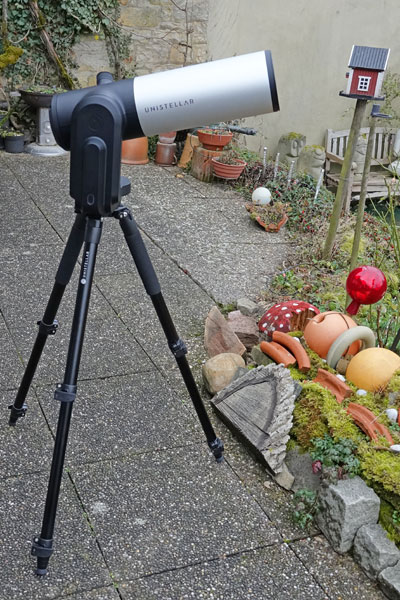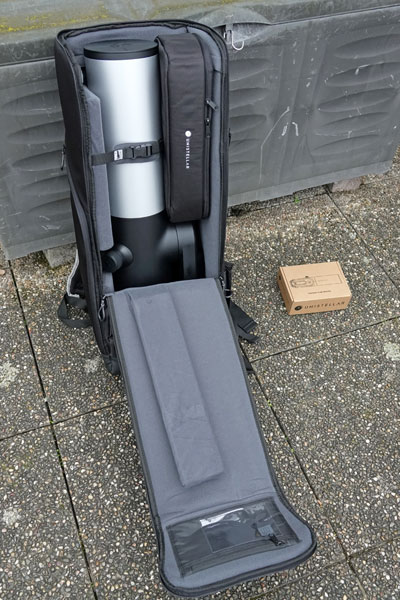Unistellar - Unistellar App Version History (Version 1)
On this page, I describe the version history of the Unistellar app for the now obsolete version 1.
Notes:
- See page Unistellar App Version History (Version 2) Archive.
- Version 2 was replaced by version 3 on January 8, 2024, which also supports the Odyssey telescopes.
- See page Overview of the Unistellar Pages Archive for just that!
Introduction
 |
 |
 |
 |
Photos: My original eVscope (End of January 2020), sold in the meantime...
Read First, Please!
My original eVscope arrived at my home at the end of January 2020. During the first weeks, it had an app with a version number below 1.0. My experiences with this early app version are reported on page First Experiences (V. 0.9).
Further Experiences: I report on my experiences with
- App version 1.0 on pages More Experiences (V. 1.0) Archive and Further Experiences (V. 1.0, V. 1.1/1.2) Archive
- App version 1.1 on page More Experiences (V. 1.1) Archive
- App version 1.2 on page More Experiences (V. 1.2) Archive
- App version 1.3 on page More Experiences (V. 1.3) Archive
- App version 1.4, 1.5, 1.6 on page More Experiences (V. 1.4/5/6) Archive
Version History
Version 1.0
App version 1.0.0 was published in Europe on March 12, 2020. Besides bug fixes, which were urgently needed, the new app version offered the following new functions:
- Possibility for taking a dark frame to remove hot pixels
- Parking function for the telescope
- Focusing aid for the eyepiece (eyepiece focus helper)
- GoTo and alignment can be aborted
- Improved battery life in cold weather
- Enlargement of the round image section from 1080 x 1080 to 1120 x 1120
Until June 2020, Unistellar "quietly" released a couple of updates:
- On March 26, a first update of the app was released (v. 1.0.1). I do not know what has changed; probably just small bux fixes. This version did not require an update of the eVscope. All in all, with the new version, I still experienced many crashes or "forced crashes" that I have to do to be able to continue observing. But I was able to observe with the eVscope very well, because it usually just keeps on working, no matter what state the app is in. Nevertheless, during my private Messier marathon from mid to late March 2020, I had the impression that I would have been much faster without these app problems...
- Version 1.0.2 was released on April 7, 2020, which also did not require an update of the eVscope. It also appeared to primarily eliminate errors (the startup screen has been changed and probably the location handling). This version asked me, whether I wanted to activate GPS - at that moment I did not even realize that the app had been updated!
- On April 21, 2020, version 1.0.3 was released, which also did not require an update of the eVscope. Again, it appeared to eliminate errors, but also brought a new, long asked-for feature: It is now possible to turn off the labelling ring (called "Overlay") in the settings ("on" is the default). Thank you, Unistellar! Furthermore, more objects were added to the object database (NGC 752 and 2264 = Christmas Tree Cluster are now included).
- On May 15, 2020, version 1.0.4 was released, which again did not require an update of the eVscope. I did not realize, which "experience improvements" were actually made, and which bugs were fixed...
- On June 15, 2020, version 1.0.5 was released, which again did not require an update of the eVscope. This time, quite a number of features were added, including German and Japanese language support and an in-app tutorial (see below for the complete list). In addition, I would like to mention tablet compatibility, which even includeded tablets without GPS that just have WiFi, like my own iPad. Except for the comfort of getting the local coordinates automatically (they can be entered manually), there would no longer be the need for me to own an iPhone...
- On June 20, 2020, version 1.0.6 was released, which again did not require an update of the eVscope. I did not realize, which "experience improvements" were actually made, and which bugs were fixed... I assume that this version was basically made to fix bugs that were introduced with version 1.0.5...
Version 1.1
- On October 5, 2020, version 1.1.0 was released, which required an update of the eVscope. It included quite a few improvements with respect to the Enhanced Vision mode and observations in general (see: Version History According to Apple App Store > Version 1.1).
- On October 13, 2020, version 1.1.1 was released (no update of the eVscope required), which brought a number of bug fixes and user experience improvements. But Unistellar did not provide any details. As I found out, the app no longer froze, when I was uploading the data to the SETI server; however, the data transfer does still not succeed. Also, when rotating the iPhone for 90°, the image now looks OK.
- On December 19, 2020, version 1.1.2 was released (no update of the eVscope required), which brought a number of bug fixes and user experience improvements. As usually, Unistellar did not provide any details, except for this one: an untimely bug in the Unistellar app was fixed that might prevent users from witnessing the conjunction of Jupiter and Saturn with the eVscope.
Version 1.2
- On January 11, 2021, version 1.2.0 was released, which again required an update of the eVscope. It included new features in the Explore tab, new citizen science modes, and some improvements and error corrections (see: Version History According to Apple App Store > 1.2).
Version 1.3
- On May 20, 2021, version 1.3 was released, which again required an update of the eVscope. It included new features such as comet data for 2021, four times the original pixel size for photos taken in Enhanced Vision mode, and some improvements and error corrections (see: Version History According to Apple App Store > 1.3).
Version 1.4
- On September 2, 2021, version 1.4.1 was released, which again required
an update of the eVscope. It did not include any new features, but only included
"eVscope experience improvements" and bug fixes ("tons of
fixes",
as Unistellar told me...). As usual, no details were given. Obviously, version
1.4.0 was skipped, and version 1.4.1 overall looks like a "bug fix" version...
(see: Version
History According to Apple App Store > 1.4.1).
Probably, the main purpose of this version was to adaopt the app to the new eVsacope 2. - On September 16, 2021, version 1.4.2 was released (no update of the eVscope required), which once again brought a number of bug fixes and "eVscope experience improvements". But Unistellar did not provide any details (see: Version History According to Apple App Store > 1.4.2).
- On October 18, 2021, version 1.4.3 was released (no update of the eVscope required), which once again brought a number of bug fixes and "eVscope experience improvements". But Unistellar did not provide any details. In the English App Store, however, some improvements were also mentioned (see: Version History According to Apple App Store > 1.4.3).
Version 1.5
- On December 13, 2021, version 1.5 was released, which again required an update of the eVscope. It did not include any new features, but only included "eVscope experience improvements" and bug fixes. As usual, no details were given (see: Version History According to Apple App Store > 1.5).
Version 1.6
- On May 2, 2022, version 1.6 was released, which again required an update of the eVscope. It did not include any new features, but only included "eVscope experience improvements" and bug fixes. As usual, no details were given (see: Version History According to Apple App Store > 1.6).
Version History According to the Apple App Store
Version 1.0
Version 1.0.0-1.0.2 (March 12, 2020; March 26, 2020; April 7, 2020)
Improve your observing experience:
- Eyepiece focus helper
- Increase battery life in cold weather
- Remove hot pixels by applying a dark frame
- And more
- Bug fixes
Version 1.0.3 (21.4.2020)
- Improving the recommended objects list in the Explore Menu.
- Making it possible to save an observation record without the Unistellar overlay.
- All the Caldwell objects are now available in the database.
- User interface and wording updates.
- Fixing issues.
- Increasing performance.
Version 1.0.4 (May 15, 2020)
- eVscope experience improvements
- Various bug fixes
Version 1.0.5 (June 15, 2020)
- Add tablet compatibility
- Add in-app tutorial
- Add German and Japanese language support
- Adapt ocular luminosity
- New category in Explore menu: Current constellation
- eVscope experience improvements
- Various bug fixes
Version 1.0.6 (June 20, 2020)
- eVscope experience improvements
- Various bug fixes
Version 1.1
Version 1.1.0 (October 5, 2020)
- Observation quality boost : Enjoy a clear and automated improvement of your stargazing
- Enhanced Vision refinements: See for how long enhanced vision has been at work, move an observation once zoomed, benefit from new advanced settings (brightness and background)
- Save images in Live mode
- Learn where the deep sky object you are observing is located in its constellation
- Rename the Wi-Fi network of your eVscope
- User interface improvements
- Various bug fixes
Version 1.1.1 (October 13, 2020)
- eVscope experience improvements
- Various bug fixes
Version 1.1.2 (December 19, 2020)
- eVscope experience improvements
- Various bug fixes
Version 1.2
Version 1.2.0 (January 11, 2021)
- New features in the Explore Tab: Fading Soon and Appearing Soon!
- New citizen science modes available
- Observing experience improvements
- Various bug fixes
Note: iOS 11 is not supported anymore
Version 1.3
Version 1.3.0 (May 20, 2021)
- Adding the most exciting comets of 2021
- Four times larger observing record for even more stunning memories of your stargazing
- Now fully compatible with the new eVscope eQuinox
- Unistellar experience improvements
- Various bug fixes
Version 1.4
Version 1.4.1 (September 2, 2021)
- eVscope experience improvements
- Various bug fixes
Version 1.4.2 (September 16, 2021)
- eVscope experience improvements
- Various bug fixes
Version 1.4.3 (October 18, 2021)
- User alerts for Enhanced Vision problem detection (my proposal!)
- Planets mode improvement
- Improved access to Science sign-up
- Eyepiece experience improvements
- eVscope experience improvements
- Various bug fixes
Version 1.5
Version 1.5.0 (December 13, 2021)
- eVscope experience improvements
- Various bug fixes
Note: last available version for iOS 12
Version 1.6
Version 1.6.0 (May 2, 2022)
- eVscope experience improvements
- Various bug fixes
Note: last available version for iOS 13
Links
- Unistellar Website: unistellaroptics.com
- See also my page offering Astronomy Links.
| 18.02.2024 |